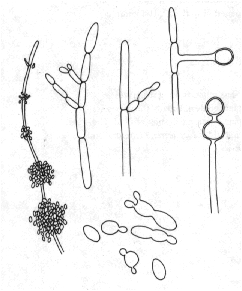Main page <> Index of descriptions <> Previous description <> Candida <> Next description

Candida
Although often appearing to be mould-like, species of Candida are really yeast fungi, differing from filamentous fungi in some rather fundamental ways. The cells of their hyphae are usually rather loosely attached and will fragment when disturbed. The spores are produced along the "hyphae" and become so numerous that the filaments can be entirely obscured. The spores can reproduce themselves by "budding". The abundance of spores can give the colony a pasty or slimy appearance. Species of Candida are common in soil and organic debris and can also cause human disease. Although these organisms often live on the bodies of humans and other mammals causing little harm, if the immune system becomes compromised by immunosuppresant drugs or disease they can cause serious infections or even death. People infected with HIV are often at risk of contracting candidiasis, the name of the disease caused by C. albicans. Not all species of Candida cause disease in humans, many occur in association with plants or insects and never affect humans at all.
Classification: Saccharomycetales, one of the so-called Hemiascomycetes or yeasts. Holomorphs: Entelexis, Hyphopichia, Issatchenkia, Metschnikowia, Saccharomycopsis, Stephanoascus. Ref: Barnett and Pankhurst 1974; Lachance et al, 2011.
Main page <> Index of descriptions <> Previous description <> Candida <> Next description